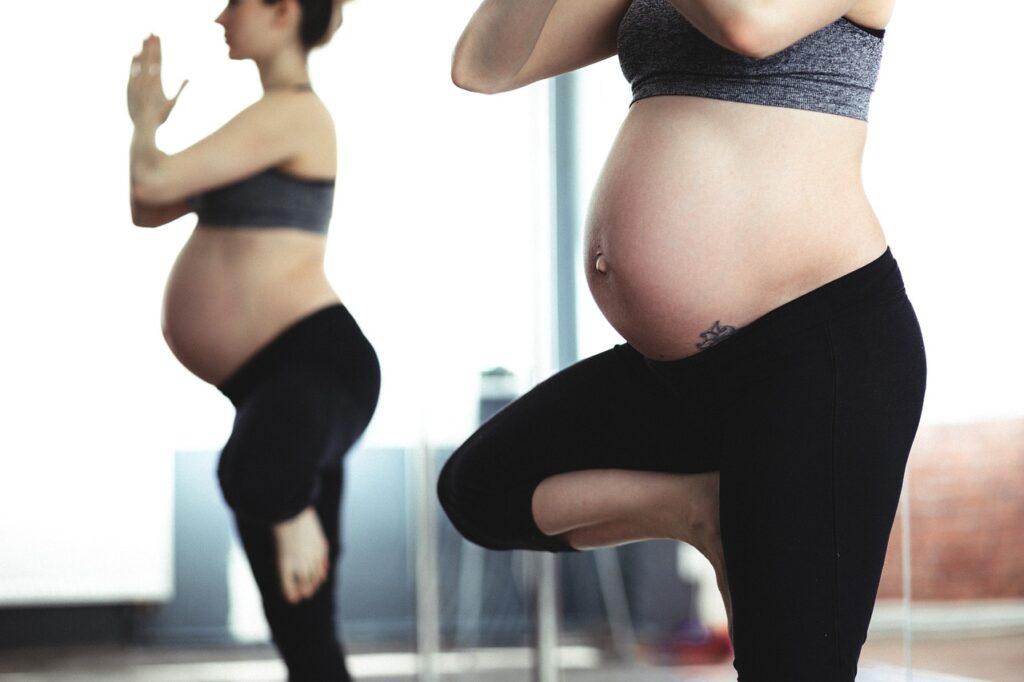
Hey there, moms-to-be!
Navigating pregnancy while keeping fit can be tricky, but it’s definitely doable with the right guidance. Let’s dive into some safe and effective exercises you can incorporate throughout your pregnancy. Remember, it’s always best to consult with your doctor before starting any new workout routine, especially during this special time.
The first trimester is crucial for your baby’s development, and it’s also a time when your body starts to undergo significant changes. If you’ve been active before pregnancy, you can generally continue your routine with some moderation. For those new to exercise, take it slow and steady. Exercise during this period helps improve mood, boosts energy levels, and can even ease some early pregnancy symptoms like fatigue and morning sickness. Regular activity can also help you sleep better, which is crucial as your body adjusts to the new life growing inside you.
Squats
Squats are fantastic for maintaining strength in your legs, hips, and buttocks. They also help strengthen your pelvic floor muscles, which can be a lifesaver post-childbirth. Squats can help prevent common pregnancy complaints like lower back pain by promoting better posture and alignment.
- How to do it: Stand with your feet shoulder-width apart, holding dumbbells at arm’s length. Lower your hips toward the floor, then return to the starting position. Aim for 1 to 3 sets of 10 repetitions.
Be cautious not to overdo it. If you feel any discomfort, stop and consult your doctor. Incorporating squats into your routine can also prepare your body for labor by enhancing the strength and flexibility of the muscles you’ll use during childbirth.
Pelvic Articulation
This yoga-inspired move is great for your hips and buttocks, and it also improves posture and balance. Pelvic articulation can help alleviate lower back pain, which is common in pregnancy, and improve your overall mobility.
- How to do it: Step one foot back, lowering your heel while keeping the other leg extended in front of you. Rotate your pelvis by opening and closing your hips. Raise one elbow back at a time to engage your upper body.
Practicing this exercise regularly can also help you develop better body awareness, which is beneficial as your center of gravity shifts during pregnancy.
Butt Press
Strengthening your core is vital during pregnancy, and the butt press targets those muscles effectively. A strong core can help support the extra weight you’re carrying, reduce the risk of diastasis recti (separation of the abdominal muscles), and improve your overall stability.
- How to do it: Lie on the floor with hips slightly back, knees bent, and arms by your sides. Press upwards through your heels, squeezing your glutes at the top. Bend one knee towards the ceiling, then return to the starting position slowly.
Including the butt press in your workout routine can also enhance your posture, which is essential for preventing back pain and ensuring comfort as your pregnancy progresses.
Kneeling Push-Ups
These are a gentler variation of the traditional push-up, focusing on your lower body. Kneeling push-ups can help maintain upper body strength without putting too much strain on your abdominal muscles.
- How to do it: Start kneeling with hands on the ground, palms facing up. Tighten your abs, bend your arms, and lower your chest towards the floor, then push back up to the starting position.
Kneeling push-ups are also great for improving core stability, which is crucial as your body changes and your balance shifts during pregnancy.

The second trimester often brings more energy, but it’s also a period of rapid growth for your baby. These exercises can help you stay comfortable and fit. Staying active during this time can help you manage weight gain, improve circulation, and reduce swelling in your legs and feet.
Mermaid Stretch
This stretch provides relief from pregnancy discomfort and prevents back pain. It also helps to lengthen and strengthen the muscles in your sides and back, promoting better posture.
- How to do it: Sit on the ground with knees folded and feet facing right. Inhale as you raise your left arm, exhale, and shift your torso to the right. Hold for three seconds, then switch sides.
The mermaid stretch can also help improve flexibility, which is beneficial as your body adapts to accommodate your growing baby.
Leg Lifts
Strengthen your abs and back with leg lifts. This exercise helps support your spine and can alleviate lower back pain, which is common as your pregnancy progresses.
- How to do it: Start on your knees and hands, lifting one knee and straightening it behind you. Repeat on the other side, aiming for four cycles.
Leg lifts can also enhance your balance and coordination, which can be helpful as your center of gravity changes.
Wall Push-Ups
A great way to work your triceps and chest without the strain of traditional push-ups. Wall push-ups can help maintain upper body strength and improve your posture.
- How to do it: Stand facing the wall with hands against it. Bend your elbows and lower your chest towards the wall, then push back up. Keep your back straight throughout.
This exercise is also excellent for maintaining arm strength, which is useful for carrying your baby after birth.
Step Back
This exercise strengthens your back muscles and stretches your lower back. It can help improve your posture and reduce the risk of back pain.
- How to do it: Stand straight, step one foot back, lower your heel, and form a diagonal line from your head to your back heel. Lift your arms, engage your glutes, and return to the starting position.
The step back also helps stretch your hip flexors, which can become tight during pregnancy.

As your body prepares for childbirth, your exercise routine should adapt. Focus on gentle, cardiovascular exercises. These can help keep your heart healthy, improve your stamina, and support your overall well-being.
Swimming
Swimming is excellent for a full-body workout without putting strain on your joints. The buoyancy of the water supports your weight, reducing the risk of injury and helping to alleviate swelling and discomfort.
Walking
Walk for 30 minutes at least three times a week. Break it into shorter periods to avoid getting too tired. Walking can help maintain cardiovascular fitness, boost your mood, and improve your overall health.
Pelvic Floor Exercises
These are crucial for maintaining pelvic health during and after pregnancy. Strengthening your pelvic floor can help prevent incontinence, support your pelvic organs, and aid in recovery after childbirth.
Yoga and Pilates
Gentle yoga and Pilates can help maintain flexibility and strength. These exercises also promote relaxation, reduce stress, and improve your overall sense of well-being.
Bodyweight Moves
Simple exercises using your body weight can be very effective. These moves can help maintain muscle tone, improve balance, and support your overall fitness.
While staying active is important, there are certain activities to avoid:
- High-Impact Exercises: Running marathons, jumping, or any high-impact activities can strain your heart and increase the risk of miscarriage. These exercises can also lead to joint injuries due to the added stress on your body.
- Hot Yoga: Exercising in high temperatures can lead to hyperthermia, which can cause complications such as premature labor or congenital disabilities.
- Weight Lifting: Heavy lifting can lead to preterm delivery or miscarriage. It’s essential to avoid activities that put excessive strain on your body.
- High-Intensity Workouts: Avoid exercises that make you hold your breath or keep your heart rate elevated for too long. These can reduce the oxygen supply to your baby.
- Sit-Ups and Planks: These can cause breathing problems and increase blood pressure in your uterus. They can also exacerbate issues like diastasis recti.

There are a lot of myths out there, so let’s clear some up:
- You Can’t Exercise While Pregnant: False! You can do many exercises, but avoid heavy lifting and consult your doctor. Staying active can actually help you feel better and support your baby’s development.
- Working Out is Dangerous for the Baby: Moderate exercise is actually beneficial for both mom and baby. It can reduce the risk of complications like gestational diabetes and preeclampsia.
- Working Out Makes You More Tired: Exercising can boost your energy levels and help you feel better overall. It also promotes better sleep, which is crucial during pregnancy.
Pay attention to your body. If you experience any of these symptoms, stop exercising and consult your doctor:
- Severe fatigue
- Headaches or joint pain
- Dizziness
- Amniotic fluid leaking
- Swelling in legs or feet
- Decreased baby movement
- Early labor contractions
- Backache
- Trouble breathing
Listening to your body is essential to ensure that you and your baby remain safe and healthy throughout your pregnancy.
After giving birth, it’s essential to ease back into exercise. Most women can start exercising about six weeks postpartum, but always check with your doctor first.
- Vaginal Delivery: You might be able to start sooner, but six weeks is a general guideline. Gentle exercises like walking and pelvic floor exercises are a good starting point.
- Cesarean Delivery: Wait until your doctor gives you the green light, typically after six weeks or more. Recovery from a cesarean delivery takes longer, so be patient and start with gentle activities.
The American College of Obstetricians and Gynecologists (ACOG) suggests that women should gradually return to physical activity to help with postpartum recovery and improve overall well-being.
Staying active during pregnancy is not only safe but beneficial for both you and your baby. With the right exercises and precautions, you can maintain your fitness and health throughout your pregnancy journey. Always consult your doctor before starting or modifying your workout routine, and listen to your body’s signals.
Embracing a balanced and mindful approach to fitness can help you enjoy a healthier, happier pregnancy and prepare you for the exciting journey of motherhood ahead.
Happy and safe exercising!


